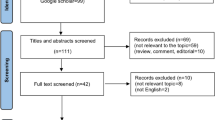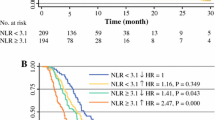Abstract
The blood neutrophil-to-lymphocyte ratio (NLR) is reported to be a prognostic marker in several cancers. However, the prognostic role of NLR in patients with advanced cholangiocarcinoma on chemotherapy is unknown. A total of 221 patients with pathologically confirmed locally advanced or metastatic cholangiocarcinoma receiving first-line palliative chemotherapy were enrolled. Associations between baseline clinical and laboratory variables including NLR and survival were investigated. Patients were classified into two groups according to the NLR level (≤5 vs. >5). Median overall survival (OS) and time to progression (TTP) in patients with NLR ≤ 5 were 10.9 and 6.7 months, respectively, and 6.8 and 4.1 months in patients with NLR > 5 (P < 0.001, P = 0.002, respectively). In multivariate analysis, number of cycles of chemotherapy was a significant predictor of longer OS (HR 0.86, P < 0.001), whereas adverse prognostic factors for OS were CA 19-9 > 300 (HR 1.43, P = 0.025), CEA > 5 (HR 1.44, P = 0.029), higher stage (HR 1.69, P = 0.004), and NLR > 5 (HR 1.87, P < 0.001). NLR > 5 was also associated with reduced TTP (HR 1.66, P = 0.007). Among 50 patients with initial NLR > 5, 33 patients had NLR ≤ 5 after two cycles of chemotherapy and they had significantly better survival than the others (HR 0.48, P = 0.015). NLR independently predicts survival in patients with advanced cholangiocarcinoma undergoing chemotherapy. Considering cost-effectiveness and easy availability, NLR may be a useful biomarker for prognosis prediction.


Similar content being viewed by others
Abbreviations
- CA 19-9:
-
Carbohydrate antigen 19-9
- CCA:
-
Cholangiocarcinoma
- CEA:
-
Carcinoembryonic antigen
- CI:
-
Confidence interval
- CR:
-
Complete response
- CRP:
-
C-reactive protein
- dNLR:
-
Derived neutrophil–lymphocyte ratio
- ECOG:
-
Eastern Cooperative Oncology Group
- HR:
-
Hazard ratio
- NLR:
-
Neutrophil–lymphocyte ratio
- NSAIDs:
-
Nonsteroidal anti-inflammatory drugs
- OS:
-
Overall survival
- PD:
-
Progressive disease
- PFS:
-
Progression-free survival
- PR:
-
Partial response
- SD:
-
Stable disease
- TTP:
-
Time to progression
References
Khan SA, Davidson BR, Goldin RD, Heaton N, Karani J, Pereira SP, Rosenberg WM, Tait P, Taylor-Robinson SD, Thillainayagam AV, Thomas HC, Wasan H, British Society of G (2012) Guidelines for the diagnosis and treatment of cholangiocarcinoma: an update. Gut 61(12):1657–1669. doi:10.1136/gutjnl-2011-301748
Coussens LM, Werb Z (2002) Inflammation and cancer. Nature 420(6917):860–867. doi:10.1038/nature01322
Rizvi S, Gores GJ (2013) Pathogenesis, diagnosis, and management of cholangiocarcinoma. Gastroenterology 145(6):1215–1229. doi:10.1053/j.gastro.2013.10.013
McNamara MG, Templeton AJ, Maganti M, Walter T, Horgan AM, McKeever L, Min T, Amir E, Knox JJ (2014) Neutrophil/lymphocyte ratio as a prognostic factor in biliary tract cancer. Eur J Cancer 50(9):1581–1589. doi:10.1016/j.ejca.2014.02.015
Gu FM, Gao Q, Shi GM, Zhang X, Wang J, Jiang JH, Wang XY, Shi YH, Ding ZB, Fan J, Zhou J (2012) Intratumoral IL-17(+) cells and neutrophils show strong prognostic significance in intrahepatic cholangiocarcinoma. Ann Surg Oncol 19(8):2506–2514. doi:10.1245/s10434-012-2268-8
Goeppert B, Frauenschuh L, Zucknick M, Stenzinger A, Andrulis M, Klauschen F, Joehrens K, Warth A, Renner M, Mehrabi A, Hafezi M, Thelen A, Schirmacher P, Weichert W (2013) Prognostic impact of tumour-infiltrating immune cells on biliary tract cancer. Br J Cancer 109(10):2665–2674. doi:10.1038/bjc.2013.610
Chua W, Charles KA, Baracos VE, Clarke SJ (2011) Neutrophil/lymphocyte ratio predicts chemotherapy outcomes in patients with advanced colorectal cancer. Br J Cancer 104(8):1288–1295. doi:10.1038/bjc.2011.100
Sharaiha RZ, Halazun KJ, Mirza F, Port JL, Lee PC, Neugut AI, Altorki NK, Abrams JA (2011) Elevated preoperative neutrophil:lymphocyte ratio as a predictor of postoperative disease recurrence in esophageal cancer. Ann Surg Oncol 18(12):3362–3369. doi:10.1245/s10434-011-1754-8
Stotz M, Gerger A, Eisner F, Szkandera J, Loibner H, Ress AL, Kornprat P, AlZoughbi W, Seggewies FS, Lackner C, Stojakovic T, Samonigg H, Hoefler G, Pichler M (2013) Increased neutrophil–lymphocyte ratio is a poor prognostic factor in patients with primary operable and inoperable pancreatic cancer. Br J Cancer 109(2):416–421. doi:10.1038/bjc.2013.332
Hakeem AR, Marangoni G, Chapman SJ, Young RS, Nair A, Hidalgo EL, Toogood GJ, Wyatt JI, Lodge PA, Prasad KR (2014) Does the extent of lymphadenectomy, number of lymph nodes, positive lymph node ratio and neutrophil–lymphocyte ratio impact surgical outcome of perihilar cholangiocarcinoma? Eur J Gastroenterol Hepatol 26(9):1047–1054. doi:10.1097/MEG.0000000000000162
Dumitrascu T, Chirita D, Ionescu M, Popescu I (2013) Resection for hilar cholangiocarcinoma: analysis of prognostic factors and the impact of systemic inflammation on long-term outcome. J Gastrointest Surg 17(5):913–924. doi:10.1007/s11605-013-2144-2
Gomez D, Morris-Stiff G, Toogood GJ, Lodge JP, Prasad KR (2008) Impact of systemic inflammation on outcome following resection for intrahepatic cholangiocarcinoma. J Surg Oncol 97(6):513–518. doi:10.1002/jso.21001
Wu XS, Shi LB, Li ML, Ding Q, Weng H, Wu WG, Cao Y, Bao RF, Shu YJ, Ding QC, Mu JS, Gu J, Dong P, Liu YB (2014) Evaluation of two inflammation-based prognostic scores in patients with resectable gallbladder carcinoma. Ann Surg Oncol 21(2):449–457. doi:10.1245/s10434-013-3292-z
Charlson ME, Pompei P, Ales KL, MacKenzie CR (1987) A new method of classifying prognostic comorbidity in longitudinal studies: development and validation. J Chronic Dis 40(5):373–383
Kanazawa M, Yoshiike N, Osaka T, Numba Y, Zimmet P, Inoue S (2005) Criteria and classification of obesity in Japan and Asia-Oceania. World Rev Nutr Diet 94:1–12. doi:10.1159/000088200
Edge SB, Compton CC (2010) The American Joint Committee on Cancer: the 7th edition of the AJCC cancer staging manual and the future of TNM. Ann Surg Oncol 17(6):1471–1474. doi:10.1245/s10434-010-0985-4
Kishi Y, Kopetz S, Chun YS, Palavecino M, Abdalla EK, Vauthey JN (2009) Blood neutrophil-to-lymphocyte ratio predicts survival in patients with colorectal liver metastases treated with systemic chemotherapy. Ann Surg Oncol 16(3):614–622. doi:10.1245/s10434-008-0267-6
Eisenhauer EA, Therasse P, Bogaerts J, Schwartz LH, Sargent D, Ford R, Dancey J, Arbuck S, Gwyther S, Mooney M, Rubinstein L, Shankar L, Dodd L, Kaplan R, Lacombe D, Verweij J (2009) New response evaluation criteria in solid tumours: revised RECIST guideline (version 1.1). Eur J Cancer 45(2):228–247. doi:10.1016/j.ejca.2008.10.026
Kusumanto YH, Dam WA, Hospers GA, Meijer C, Mulder NH (2003) Platelets and granulocytes, in particular the neutrophils, form important compartments for circulating vascular endothelial growth factor. Angiogenesis 6(4):283–287. doi:10.1023/B:AGEN.0000029415.62384.ba
Balkwill F, Mantovani A (2001) Inflammation and cancer: back to Virchow? Lancet 357(9255):539–545. doi:10.1016/S0140-6736(00)04046-0
Mantovani A, Allavena P, Sica A, Balkwill F (2008) Cancer-related inflammation. Nature 454(7203):436–444. doi:10.1038/nature07205
Diakos CI, Charles KA, McMillan DC, Clarke SJ (2014) Cancer-related inflammation and treatment effectiveness. Lancet Oncol 15(11):e493–e503. doi:10.1016/S1470-2045(14)70263-3
Lönnroth C, Andersson M, Arvidsson A, Nordgren S, Brevinge H, Lagerstedt K, Lundholm K (2008) Preoperative treatment with a non-steroidal anti-inflammatory drug (NSAID) increases tumour tissue infiltration of seemingly activated immune cells in colorectal cancer. Cancer Immun 8:5–15
Coward J, Kulbe H, Chakravarty P, Leader D, Vassileva V, Leinster DA, Thompson R, Schioppa T, Nemeth J, Vermeulen J, Singh N, Avril N, Cummings J, Rexhepaj E, Jirstrom K, Gallagher WM, Brennan DJ, McNeish IA, Balkwill FR (2011) Interleukin-6 as a therapeutic target in human ovarian cancer. Clin Cancer Res 17(18):6083–6096. doi:10.1158/1078-0432.CCR-11-0945
Germano G, Mantovani A, Allavena P (2011) Targeting of the innate immunity/inflammation as complementary anti-tumour therapies. Ann Med 43(8):581–593. doi:10.3109/07853890.2011.595732
Tam CS, Verstovsek S (2013) Investigational janus kinase inhibitors. Expert Opin Investig Drugs 22(6):687–699. doi:10.1517/13543784.2013.774373
Henao-Mejia J, Elinav E, Strowig T, Flavell RA (2012) Inflammasomes: far beyond inflammation. Nat Immunol 13(4):321–324. doi:10.1038/ni.2257
Chen R, Alvero AB, Silasi DA, Mor G (2007) Inflammation, cancer and chemoresistance: taking advantage of the toll-like receptor signaling pathway. Am J Reprod Immunol 57(2):93–107. doi:10.1111/j.1600-0897.2006.00441.x
Kelly MG, Alvero AB, Chen R, Silasi DA, Abrahams VM, Chan S, Visintin I, Rutherford T, Mor G (2006) TLR-4 signaling promotes tumor growth and paclitaxel chemoresistance in ovarian cancer. Cancer Res 66(7):3859–3868. doi:10.1158/0008-5472.CAN-05-3948
Nakanishi C, Toi M (2005) Nuclear factor-kappaB inhibitors as sensitizers to anticancer drugs. Nat Rev Cancer 5(4):297–309. doi:10.1038/nrc1588
Proctor MJ, McMillan DC, Morrison DS, Fletcher CD, Horgan PG, Clarke SJ (2012) A derived neutrophil to lymphocyte ratio predicts survival in patients with cancer. Br J Cancer 107(4):695–699. doi:10.1038/bjc.2012.292
Szkandera J, Gerger A, Liegl-Atzwanger B, Stotz M, Samonigg H, Friesenbichler J, Stojakovic T, Leithner A, Pichler M (2015) The derived neutrophil/lymphocyte ratio predicts poor clinical outcome in soft tissue sarcoma patients. Am J Surg 210(1):111–116. doi:10.1016/j.amjsurg.2014.10.021
Szkandera J, Stotz M, Eisner F, Absenger G, Stojakovic T, Samonigg H, Kornprat P, Schaberl-Moser R, Alzoughbi W, Ress AL, Seggewies FS, Gerger A, Hoefler G, Pichler M (2013) External validation of the derived neutrophil to lymphocyte ratio as a prognostic marker on a large cohort of pancreatic cancer patients. PLoS ONE 8(11):e78225. doi:10.1371/journal.pone.0078225
Absenger G, Szkandera J, Pichler M, Stotz M, Arminger F, Weissmueller M, Schaberl-Moser R, Samonigg H, Stojakovic T, Gerger A (2013) A derived neutrophil to lymphocyte ratio predicts clinical outcome in stage II and III colon cancer patients. Br J Cancer 109(2):395–400. doi:10.1038/bjc.2013.346
Author contributions
Sang Hyub Lee involved in conception and design; Ban Seok Lee, Dong Kee Jang, Kwang Hyun Chung, Jun Hyuk Son collected and assembled of data; Sang Hyub Lee, Ji Kon Ryu, Yong-Tae Kim provided study materials or patients; Ban Seok Lee, Woo Hyun Paik involved in data analysis and interpretation; Ban Seok Lee, Sang Hyub Lee, Woo Hyun Paik wrote the manuscript; All authors finally approved the manuscript.
Author information
Authors and Affiliations
Corresponding author
Ethics declarations
Conflict of interest
The authors declare that they have no conflict of interest.
Ethical approval
All procedures performed in studies involving human participants were in accordance with the ethical standards of the institutional and/or national research committee and with the 1964 Helsinki declaration and its later amendments or comparable ethical standards. For this type of study, formal consent is not required.
Electronic supplementary material
Below is the link to the electronic supplementary material.
Rights and permissions
About this article
Cite this article
Lee, B.S., Lee, S.H., Son, J.H. et al. Neutrophil–lymphocyte ratio predicts survival in patients with advanced cholangiocarcinoma on chemotherapy. Cancer Immunol Immunother 65, 141–150 (2016). https://doi.org/10.1007/s00262-015-1780-7
Received:
Accepted:
Published:
Issue Date:
DOI: https://doi.org/10.1007/s00262-015-1780-7




